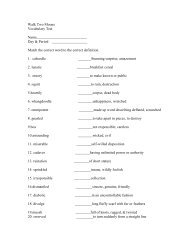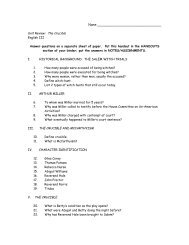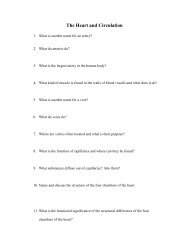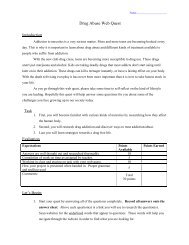7th Grade Reading
7th Grade Reading
7th Grade Reading
- No tags were found...
Create successful ePaper yourself
Turn your PDF publications into a flip-book with our unique Google optimized e-Paper software.
The following editorial expresses the feelings a girl has about zoos.Zoos: Joys or Jails?Rachel F., San Diego, CAImagine your family lives in a luxurious mansion where all your needs are provided for.There are gardens and daily walks and all your favorite foods.Suddenly, you’re taken from your home and shipped to a place where people come from farand wide to ogle at you, thinking they are learning about your lifestyle. Sometimes, your captorsforce you to perform for thousands of people.Your life had changed drastically. Welcome to the zoo!Behind Bars: Behavior in CaptivityAlthough the circumstances and reasons for animals being in zoos vary, its concept hadfaults many don’t notice during their visit with the animals. Animals in many zoos are kept in areasthat are much smaller than their natural habitats. As a result, animals behave differently than theywould in their natural surroundings. Animals like big cats are accustomed to roaming territories ofup to 10 square miles.One of the best aspects of the zoo is its emphasis on education. Signs tell visitors about theanimals and their behavior in the wild, but notice how the majority say the animals were born in thezoo. Unfortunately, the adaptive behavior due to small cages gives visitors a skewed perception ofhow the animals actually behave in the wild. Although the idea of education to protect and preserveanimals is excellent, is the zoo really setting a good example of treatment or representing thenatural actions of these creatures?Survival TechniquesSome advocates say that zoos protect and serve endangered species. Despite today’sadvanced breeding techniques, animals raised in the zoo or other places of captivity are not learningthe survival techniques they would in the wild. These animals would be very vulnerable if releasedand would encounter difficulties coping. Would it not be more beneficial to raise them in theirnatural habitat?In this way scientists wouldn’t face as many risks in reintroducing captive animals raised intothe wild.Helping endangered species in the wild gives them a better chance for survival andreproduction. Scientists should only revert to the zoo if the necessary funding or habitat forbreeding is not available.Animal PerformancesAnimals are not just brought to the zoo to protect their species, but also to provideentertainment. Many animals’ lives will include performing for visitors. Four shows are performedevery day at the San Diego Zoo. The zoo should be reserved for education and protectingendangered species, not an amusement park where animals are trained to perform.Although the zoo is trying to be helpful in providing shows about animals, it is harming thoseit intends to protect. The zoo had good intentions in its educational purposes, and in breedingendangered species, but animals shouldn’t perform or be treated in a manner that could changetheir behaviors from how they act in the wild.Though zoos are meant to be a joy to viewers and teach lessons about out earth, the zoojails its inhabitants and passes on faulty knowledge. The wild animals in our world are a wonder,and they must be preserved. At the zoo they are treated with care, but they should be treated withreverence.Next time you visit a zoo, look at the enclosure of the tigers and watch the seal balance a ballon their noses, and think about what you are really learning from your day at the zoo.5PLEASE GO ON TO THE NEXT PAGE
















